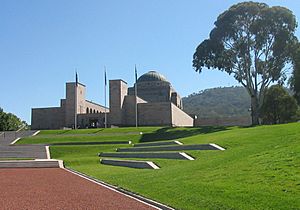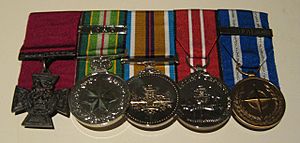Victoria Cross for Australia facts for kids
Quick facts for kids Victoria Cross for Australia |
|
|---|---|
|
Obverse of the medal and ribbon. Ribbon: 32 mm, crimson
|
|
| Type | Military decoration |
| Eligibility | Australian military personnel and other persons approved by the minister of Defence |
| Awarded for | "[T]he most conspicuous bravery, or some daring or pre-eminent act of valour or self-sacrifice, or extreme devotion to duty in the presence of the enemy." |
| Status | Currently awarded |
| Description | Bronze cross pattée with crown and lion superimposed, and motto: 'For Valour' |
| Post-nominals | VC |
| Statistics | |
| Established | 15 January 1991 |
| Order of Wear | |
| Next (higher) | none |
| Equivalent | Victoria Cross |
| Next (lower) | George Cross, Cross of Valour |
The Victoria Cross for Australia is the highest award for bravery in Australia. It is given to people who show amazing courage and self-sacrifice when facing an enemy. This award is the most important one in the Australian honours system. It replaced the British Victoria Cross for Australians.
The Victoria Cross for Australia was created on 15 January 1991. This happened when Elizabeth II, the Queen of Australia, signed official documents. She did this based on advice from Prime Minister Bob Hawke. This medal is considered equal to the original British Victoria Cross. It is the highest award in Australia. Members of the Australian Defence Force can receive it. Other people approved by the Australian Minister for Defence can also get it. If someone receives this award, they can use the letters VC after their name.
The Governor-General of Australia presents the Victoria Cross for Australia. This happens with the Queen's approval. The Minister for Defence recommends who should receive it. As of February 2021, five Victoria Crosses for Australia had been awarded. Two of these were given after the person had died. The first award was given on 16 January 2009. It went to Trooper Mark Donaldson. He bravely rescued an interpreter under heavy fire in Uruzgan Province in Afghanistan.
Contents
History of the Victoria Cross
The First Victoria Cross
The original Victoria Cross was started on 29 January 1856 by Queen Victoria. It was created to recognise brave actions during the Crimean War. The medals were meant to be made from parts of cannons captured from the Russians. However, later research showed the metal actually came from old Chinese guns.
The cannons used to make the medals are outside the Officers' Mess at the Royal Artillery Barracks in Woolwich. A small piece of the original cannon metal is kept safe. It is believed that enough metal remains to make many more Victoria Crosses. A company called Hancocks of London has made every medal since the beginning. Both the Australian and New Zealand Victoria Crosses are made from this same special metal.
The original medal was given to 96 Australians. Most of these were for actions while serving in Australian forces. Sixty-four awards were for actions in the First World War. Nine of these were for bravery during the Gallipoli Campaign. Twenty medals were given for actions in the Second World War. Others were for the Second Boer War, Russian Civil War, and Vietnam War. The last Australian to receive the original Victoria Cross was Warrant Officer Keith Payne. He received it on 24 May 1969 for his courage during the Vietnam War. Payne rescued over 40 men.
New Awards for Commonwealth Countries
After the Second World War, many Commonwealth countries started their own awards systems. These were separate from the British honours system. Countries like Australia, Canada, and New Zealand created their own highest awards for bravery. They named these awards after the British Victoria Cross. However, they are unique awards for each country.
Australia was the first Commonwealth country to create its own Victoria Cross. This happened on 15 January 1991. The Victoria Cross for Australia looks exactly like the British one. Canada created its own version in 1993. The Canadian medal has a different saying on it. It also uses a mix of metals. New Zealand created its Victoria Cross for New Zealand in 1999. It looks the same as the Australian and British versions. It has been awarded once to Corporal Willie Apiata.
What the Medal Looks Like
The Victoria Cross for Australia looks just like the original design. It is a bronze cross shape. It is about 41 millimetres tall and 36 millimetres wide. The medal has a Crowned Lion standing on a Royal Crown. Below this, it says 'FOR VALOUR' on a curved scroll. The back of the medal has the date of the brave act engraved on it. The words 'FOR VALOUR' were chosen by Queen Victoria. She thought it was important to show that all soldiers were brave.
The cross hangs from a "V" shape connected to a bar. This bar has laurel leaves on it. The ribbon goes through this bar. The back of the bar has the recipient's name, rank, and unit engraved. The ribbon is crimson, which is a deep red colour. It is about 38 millimetres wide.
How the Award is Given
The Victoria Cross for Australia is given for:
- "Most obvious bravery"
- "Daring or outstanding acts of courage or self-sacrifice"
- "Extreme dedication to duty when facing the enemy"
The Governor-General gives out the awards. This needs the approval of the Queen. The rules for the Australian Victoria Cross are a bit different from the original. They allow for "other persons" to be considered for the award. This might mean police officers or civilians could be eligible during a terrorist act. If someone receives the Victoria Cross for Australia more than once, they get a small bar added to the medal.

The Victoria Cross for Australia is the highest award in the Australian Honours Order of Precedence. This means it is more important than all other Australian awards. It is equal in importance to the original British Victoria Cross. People who receive the award can use "VC" after their name. This honour is only for the person who earned it. It does not pass to their family.
It is a tradition for even the highest-ranking officers to salute a Victoria Cross recipient. This shows great respect for their brave act. The Australian Government also pays a special allowance to anyone who receives the medal. This amount is updated each year.
The Victoria Cross medals are very valuable. On 24 July 2006, a VC medal awarded to Captain Alfred John Shout from the First World War sold for $1 million. Captain Shout received his award after he died in 1915. He was recognised for his bravery in hand-to-hand fighting at Lone Pine in Gallipoli, Turkey. The buyer, Kerry Stokes, loaned the medal to the Australian War Memorial. It is displayed there with other Victoria Crosses. The Australian War Memorial in Canberra has a large collection of these medals.
Cancelling an Award
The Governor-General can take back a Victoria Cross. No Australians have had their Victoria Cross taken away. The British Victoria Cross also has rules for this. Only 8 awards were cancelled between 1861 and 1908. Since the 1920s, awards have usually only been cancelled if they were gained falsely. Or if the actions recognised involved a serious crime.
Recipients of the Victoria Cross for Australia
Mark Donaldson
The first Victoria Cross for Australia was given to Trooper Mark Donaldson. He was part of the Special Air Service Regiment. Governor-General Quentin Bryce presented the award on 16 January 2009. On 2 September 2008, Donaldson rescued an interpreter. This happened under heavy enemy fire in Oruzgan province during Operation Slipper in Afghanistan.
His award citation described his actions:
- He moved quickly between safe spots, firing at the enemy.
- He bravely exposed himself to enemy fire to draw attention away from wounded soldiers. This gave time for the wounded to be moved to safety.
- During a difficult retreat, a wounded interpreter was left behind. Corporal Donaldson, without thinking of his own safety, went alone across 80 metres of open ground to rescue him.
- He picked up the interpreter and carried him back to safety. He then gave him first aid before rejoining the fight.
- He also gave medical care to other wounded soldiers while still fighting the enemy.
Corporal Donaldson's actions showed amazing courage. They saved the life of the interpreter and kept other soldiers safe.
Ben Roberts-Smith
Corporal Ben Roberts-Smith MG of the Special Air Service Regiment received the second Victoria Cross for Australia. This was on 23 January 2011. Corporal Roberts-Smith was awarded the medal for bravely attacking and destroying two Taliban machine gun positions. This happened during the Shah Wali Kot Offensive in Afghanistan on 11 June 2010. He had also received a Medal for Gallantry in 2006.
In 2023, a court found that some serious actions had occurred during his service.
Daniel Keighran
Corporal Daniel Keighran of the 6th Battalion, Royal Australian Regiment received the Victoria Cross for Australia on 1 November 2012. This was for his actions in the Battle of Derapet in Oruzgan province, Afghanistan, in August 2010. Corporal Keighran deliberately put himself in harm's way. He drew enemy fire away from an injured friend and those helping him. He was the third person to receive the award. He was also the first recipient not from the Special Forces.
Cameron Baird
On 13 February 2014, Prime Minister Tony Abbott announced a posthumous Victoria Cross for Corporal Cameron Baird. Corporal Baird was part of the 2nd Commando Regiment. He had received the Medal for Gallantry in 2007. He was killed in Afghanistan in 2013.
Edward "Teddy" Sheean
On 12 August 2020, the Queen approved the Victoria Cross for Australia for Edward "Teddy" Sheean. Sheean's case was reviewed several times. In June 2020, Prime Minister of Australia Scott Morrison asked a group of experts to review the decision. On 10 August 2020, Morrison accepted their findings. He recommended that the Queen award Sheean the Victoria Cross for Australia after his death.
Richard Norden
On 1 October 2024, Richard Norden was awarded the Victoria Cross for Australia after his death. This was for his actions on 14 May 1968. These actions took place during the Battle of Coral–Balmoral in the Vietnam War.
Proposed Awards from the Past
There have been discussions about giving the Victoria Cross for Australia to people for brave acts from long ago. In 2001, some politicians tried to pass a law to award the Victoria Cross for Australia to certain people. These awards would have been given after their deaths.
The proposed awards were for John Simpson Kirkpatrick ("Simpson"), Albert Cleary, and Teddy Sheean. These were for their actions in the First and Second World Wars. Simpson's story is famous in Australia. He was a stretcher bearer at Gallipoli during the First World War. He used a donkey to carry wounded soldiers from the battlefield to the beach. He did this for weeks, often under fire, until he was killed. However, in 1919, King George V said no more awards would be given for that war.
In 1965, a campaign started to give Simpson the Victoria Cross. His image with a donkey appeared on a special medal. After the 2007 election, there was talk of bringing back the idea of these awards. Some historians believe that the Victoria Cross for Australia should not be given for past events. In 2011, the Australian government looked into 13 cases of bravery from the past. The group reviewing these cases decided not to recommend any new awards.
See also
 In Spanish: Cruz Victoria para Australia para niños
In Spanish: Cruz Victoria para Australia para niños



